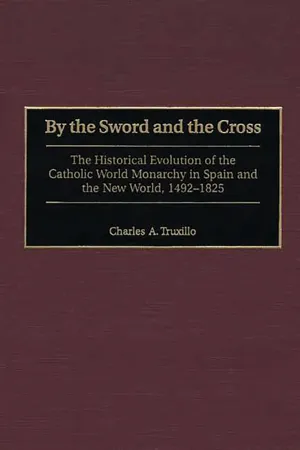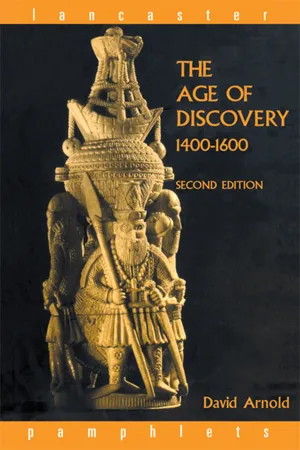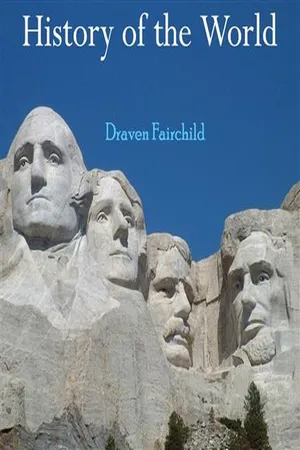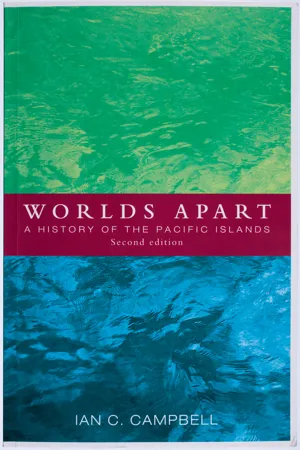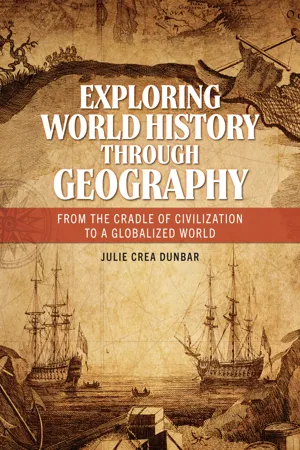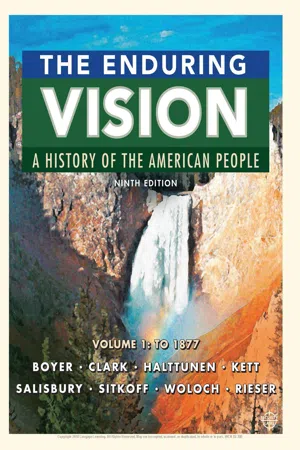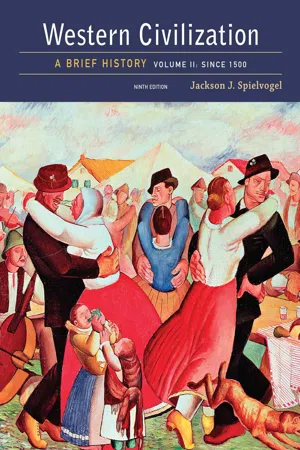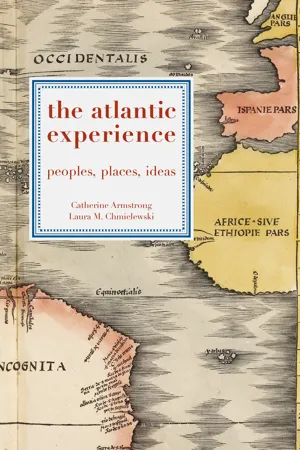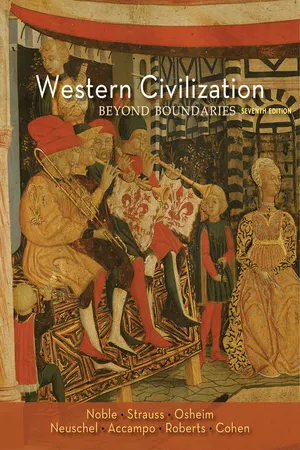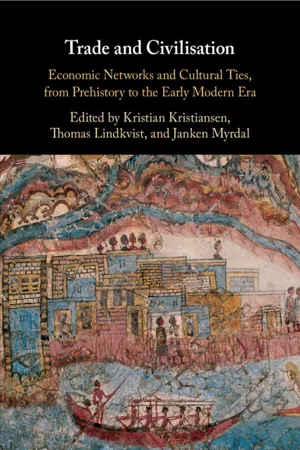History
Age of Exploration
The Age of Exploration refers to the period from the 15th to 17th centuries when European powers embarked on voyages of discovery and colonization around the world. This era saw significant advancements in navigation, shipbuilding, and cartography, leading to the exploration and eventual colonization of the Americas, Africa, and Asia. The Age of Exploration had far-reaching impacts on global trade, culture, and geopolitics.
Written by Perlego with AI-assistance
Related key terms
1 of 5
11 Key excerpts on "Age of Exploration"
- eBook - PDF
By the Sword and the Cross
The Historical Evolution of the Catholic World Monarchy in Spain and the New World, 1492-1825
- Charles A. Truxillo(Author)
- 2001(Publication Date)
- Praeger(Publisher)
Chapter 3 The Age of Discovery, Exploration, and Conquest, 1492-1556 SETTING THE STAGE At the end of the fifteenth century, European peoples living along the Atlantic coast began their great era of seaborne imperialism. The Age of Discovery and Explora- tion occurred at the same time as the Italian Renaissance. And though the two movements were not related, the intellectual expansiveness of the Renaissance made it easier for Europeans to assimilate aspects of the New World. By exploring and conquering the Americas, western Europeans were also able to increase the relative weight of their civilization in world affairs. Eventually the resources pro- vided by the New World tipped the age-old balance of Eurasian civilizations in favor of Europe. In this sense, the Age of Exploration was a turning point in world history (McNeill 1963). Since the retreat of Hellenism in the seventh century (A.D.) and the failure of the Crusades in the thirteenth century, Europeans had been con- fined to the western end of the Afro-Eurasian world island. When Columbus and Vasco de Gama sailed on their epic voyages at the end of the fifteenth century, it still seemed likely that the Ottoman Turks would overrun the whole of Christen- dom. A century later, the entire planet was beginning to feel the impact of the Euro- peans and their sailing gun ships, for the Atlantic maritime tradition facilitated European nations sailing with impunity throughout the world's oceans. Heavy-ship construction, necessary in the stormy waters of the North Atlantic, was combined, in the fifteenth century, with elements of Mediterranean naval technology, such as the lanteen sail, the compass, and portolan charts (Scammell 1989). The Portuguese were pioneers in the synthesis of maritime traditions. The vessels they built sailed throughout the world's oceans; moreover, they proved nearly invincible when armed with cannon. - eBook - ePub
- David Arnold(Author)
- 2013(Publication Date)
- Routledge(Publisher)
Part One The Meaning of ‘Discovery’ It could be argued that there have been many ‘ages of discovery’ in history, involving many different peoples and civilizations, and that it is inappropriate to single out this period as being the Age of Discovery. Equally, it could be questioned whether this was anything more than an age of European exploration and aggrandisement, a phase in the history of the West that left many other societies around the world relatively unaffected. It is hard, however, to doubt the overall significance of this period, by whatever name we call it. Though the era of maritime expansion could be pushed back to AD 800 to include the early voyages of the Vikings or carried forward into the seventeenth and eighteenth centuries when Europe gained a wealth of new knowledge about areas of the globe hitherto little investigated (such as the South Pacific and Australasia or the vast interior regions of Africa, Asia and North America), the essential geographical discoveries, including the exploration of the West African coast, the discovery of the ‘New World’ and the Cape route to the Indies, and the first circumnavigation of the globe, were all made between the early fifteenth and mid-sixteenth centuries. Writers as diverse in their opinions as Adam Smith in The Wealth of Nations in 1776 and Karl Marx and Frederick Engels in the Communist Manifesto of 1848 saw the discovery of America and the rounding of the Cape as among the principal events in history and as laying the basis, economically and politically, for the modern world. Many recent historians have endorsed this view and provided fresh evidence for the foundational importance of the Age of Discovery. In this remarkably short period, Europeans acquired an unparalleled knowledge of the rest of the world - No longer available |Learn more
- (Author)
- 2014(Publication Date)
- Learning Press(Publisher)
___________________________ WORLD TECHNOLOGIES ___________________________ Chapter- 7 Age of Discovery Cantino planisphere 1502, earliest surviving chart showing the explorations of Columbus to Central America, Corte-Real to Newfoundland, Gama to India and Cabral to Brazil. Tordesillas line depicted, Biblioteca Estense, Modena The Age of Discovery , also known as the Age of Exploration , was a period in history starting in the 15th century and continuing into the early 17th century during which Europeans engaged in intensive exploration of the world, establishing direct contacts with Africa, the Americas, Asia and Oceania and mapping the planet. Historians often refer to the 'Age of Discovery' as the pioneer Portuguese and Spanish long-distance maritime travels in search of alternative trade routes to the Indies, moved by the trade of gold, silver and spices. The Portuguese began systematically exploring the Atlantic coast of Africa from 1418, under the sponsorship of Prince Henry, reaching the Indian Ocean by this route in 1488. In 1492, racing to find a trade route to Asia, the Spanish monarchs funded Christopher Columbus’ plan to sail west to reach the “Indies” by crossing the Atlantic. He landed on an uncharted continent, then seen by Europeans as a “new world”, America. To prevent conflict between Portugal and Spain, a treaty was signed dividing the world into two regions of exploration, where each had exclusive rights to claim newly discovered lands. In 1498, a Portuguese expedition commanded by Vasco da Gama finally achieved the dream of reaching India by sailing around Africa, opening up direct trade with Asia. Soon, the Portuguese sailed further eastward, to the valuable “spice islands” in 1512, landing in China one year later. East and west exploration overlapped in 1522, when Ferdinand - eBook - ePub
Worlds Apart
A History of the Pacific Islands
- Ian C. Campbell(Author)
- 2016(Publication Date)
- Canterbury University Press(Publisher)
CHAPTER THREEThe Age of European DiscoveryT HERE IS NO sharp break between pre-European and European Pacific history. The coming of Europeans was sporadic, intermittent and protracted; it varied immensely in intensity and character. Meanwhile, Pacific islanders went about their affairs according to their normal mode of life: indigenous history-making did not cease, but it did begin to be recorded in writing, albeit unevenly and incompletely.European exploration of the Pacific was undertaken for complicated reasons, not for any single one. Indeed the word ‘exploration’, implying deliberate, systematic investigation, is itself misapplied to much of the process because many discoveries were simply incidental to the main purpose of the various voyagers. These multifarious purposes are part of the history of Europe since Renaissance times, when political, economic and intellectual ferment encouraged Europeans to go out into the wider world of which hitherto they had occupied only the fringe.Spanish beginnings
At the end of the 15th century the Spanish discovered the New World of the Americas across the Atlantic and began to exploit its wealth; and Portugal had found the sea route to India by circumnavigating Africa. Between these two events, the Spanish and Portuguese had agreed to a division of their interests in the world by the Treaty of Tordesillas in 1494. Spain claimed the western hemisphere, and Portugal the eastern. Within less than 20 years the Portuguese had a chain of trading posts or bases at strategic places in the Indian Ocean and as far as Canton in China. Lucrative though their American possessions were, the Spanish resented being shut out of Asian trade and a dispute arose as to where the Asian extension of the line of demarcation between these two powers fell.In 1521 Ferdinand Magellan became the first navigator to cross the Pacific, in a successful attempt to show that Spain could access Asia without traversing the prohibited Indian Ocean. In other respects, Magellan’s expedition was disastrous, not least because the distance involved made the journey virtually suicidal. Spain’s future expeditions across the Pacific to Asia therefore set out from the newly acquired territory on the west coast of Mexico. There were two more in the 1520s, another in 1542, and finally, in 1564, an expedition was sent to establish a colony. Thus began the Spanish conquest of the Philippine Islands, and with it the inauguration of an annual voyage of a treasure galleon, the first regular traffic across the Pacific. The Spanish stumbled on other islands in the course of these voyages, in the Marshall and Mariana Islands, and later among the Caroline and Gilbert Islands, but it was only in Guam that they showed any interest, regarding it as a place of refreshment towards the end of the long voyage from Mexico to Manila. The hope of plundering Spanish treasure brought English predators into the Pacific. Francis Drake circumnavigated the globe in 1577–80, and in 1588 he was followed by Thomas Cavendish. These piratical adventures added nothing to European knowledge of the ocean or its islands. - eBook - ePub
Exploring World History through Geography
From the Cradle of Civilization to a Globalized World
- Julie Crea Dunbar(Author)
- 2022(Publication Date)
- ABC-CLIO(Publisher)
The impact of the Ottomans on European trade was so significant that European leaders began sponsoring exploration for water routes to the Far East that avoided Mediterranean and overland routes. Countries with easy access to the Atlantic, such as England, France, Portugal, Spain, and the Netherlands, had a geographical advantage in the race to the East. They expanded their knowledge of the human and physical geography of the world: they found new continents and peoples; filled in empty spaces on the world map; launched an era of colonization and the slave trade; and initiated a massive Columbian Exchange of people, animals, food, and even disease. And they found water routes to the east. The impact of this Age of Exploration on global history cannot be understated. It transformed the lives of millions—not always for the better—altered environments, and set in motion a series of developments that would eventually lead to the Industrial Revolution.A ROUTE EAST
European knowledge of geography and technology in the early 15th century presented limitations. Up to this point, European navigators depended on coastal navigation. The design of their ships, lack of knowledge about trade winds, as well as their lackluster navigational technology prevented extended deepwater voyages. The desire to expand trade routes to the east, however, influenced European nations to develop better technology to get there—better maps, better ships, and better navigational tools. For that, Portugal took the lead, as the first European kingdom to initiate long-distance exploration by ship.The Portuguese were the first to seek a water route to India and China that circumvented the Ottoman Empire. To get to Asia by water, however, European mariners knew they would need to sail around Africa, if they were to sail east. European geographic knowledge of Africa was limited at the time. The furthest south any European had sailed on Africa’s west coast was Cape Bojador in Western Sahara, which is in far northwestern Africa. They had no idea that the continent of Africa extended about 5,000 miles from north to south.King Duarte (or Edward, in English) of Portugal gave his brother Prince Henry (who became known as “the Navigator”) the authority to authorize expeditions to explore the west coast of Africa. Such a task required the development of a new kind of ship—one that was easily maneuverable in both deep ocean and shallow, coastal waters. Portuguese shipbuilders responded to the need with the caravel—a light sailing ship with a closed galley. It was remarkably fast and easily maneuverable and could even sail into the wind. The caravel had two to three masts and rudders to “steer” instead of steersman’s oars. It was of lighter weight and had a shallow keel, allowing for navigation in coastal waters, and even deep rivers. Smaller than the Spanish galleon (to come in the 16th century), the caravel could still withstand deep ocean voyages and carry heavy cargo. Ship-mounted cannons defended the cargo and, alternatively, in the case of piracy, could also attack and fight for another ship’s cargo. - eBook - ePub
- Robert M Ziomkowski(Author)
- 2012(Publication Date)
- Research & Education Association(Publisher)
CHAPTER 7 Early Modern Europe CHAPTER 7 EARLY MODERN EUROPE THE Age of Exploration During the Renaissance and Reformation, Europeans were embarking upon naval expeditions that looked beyond the confines of their world. The leaders in these voyages of discovery were the Portuguese and Spanish, who sometimes hired Italian captains. Prince Henry the Navigator. A Portuguese prince known as Henry the Navigator (1394–1460) gave the first major impetus to exploration by funding voyages of discovery and establishing a school for navigation at Sagres, which included an observatory. He also made improvements in shipbuilding, and the caravel was adopted as the favored vessel for exploration. Henry’s motives reflected military, religious, and economic concerns. His patronAge of Exploration began after he participated in the 1415 capture of Ceuta, a Muslim stronghold in North Africa across from the Strait of Gibraltar. He hoped that a more precise knowledge of African geography would help Christian forces to outflank the Muslims and thus gain a strategic advantage over them. He also hoped to make contact with a legendary figure named Prester John, who was rumored to rule a Christian kingdom in distant lands (possibly Ethiopia). More realistically, Henry thought to discover and convert pagans who lived on the edge of Muslim territories, thereby combining religious with military motives. Finally, Henry hoped to find deposits of gold and to generate wealth for Portugal by establishing a trade route to the Indies that could bypass the Mediterranean, which was dominated by the Italians and Turks. Portuguese Exploration. With the support of Prince Henry, Portuguese explorers discovered the Azores, Canary, and Cape Verde Islands in the Atlantic Ocean and followed the African coast as far as Sierra Leone near the equator. They established a lucrative trade in gold, ivory, and slaves - No longer available |Learn more
The Enduring Vision
A History of the American People, Volume 1: To 1877
- Paul Boyer, Clifford Clark, Karen Halttunen, Joseph Kett(Authors)
- 2017(Publication Date)
- Cengage Learning EMEA(Publisher)
The Rise of the Atlantic World, 1400–1625 The Context for European Exploration (24) How does an awareness of the social and political context in Europe enrich our understanding of early American exploration and history? European Culture and Society Traditional Values in Flux Religious Fractures The Impact of the Reformation in England, 1533–1625 Exploration, Interaction, and Early Contact in the Atlantic World, 1400–1600 (30) What shaped the early exchanges between Europeans, Native Americans, and Africans during their initial contact in the late fifteenth and sixteenth centuries? Portugal and the Atlantic, 1400–1500 African Trade, the “New Slavery,” and Racism To the Americas and Beyond, 1492–1522 Spain’s Conquistadors, 1492–1536 The Columbian Exchange Footholds in North America, 1512–1625 (38) What is the best way to understand the differences between the early settlements that various European countries established in North America? Spain’s Northern Frontier France: Colonizing Canada England and the Atlantic World, 1558–1603 Failure and Success in Virginia, 1603–1625 New England Begins, 1614–1625 A “New Netherland” on the Hudson, 1609–1625 The Whole Vision (47) 2 BARTHOLOMEW GOSNOLD TRADING WITH WAMPANOAG INDIANS AT MARTHA’S VINEYARD (1602) BY THEODORE DE BRY, 1634 Exchanges between Native Americans and Europeans transformed the Atlantic Ocean from a barrier to a bridge linking Earth’s two hemispheres. (MPI/Getty Images) Copyright 2018 Cengage Learning. All Rights Reserved. May not be copied, scanned, or duplicated, in whole or in part. WCN 02-300 C. 1400–1600 European Renaissance. Coastal West African kingdoms rise and fall as slave trade expands. C. 1440 Portuguese slave trade in West Africa begins. C. 1450 Songhay succeeds Mali as major power in West African grassland. 1492 Christian “reconquest” of Spain. Columbus lands at Guanahaní. 1498 Vasco da Gama rounds the Cape of Good Hope and reaches India. - eBook - PDF
Western Civilization
A Brief History, Volume II: Since 1500
- Jackson Spielvogel(Author)
- 2016(Publication Date)
- Cengage Learning EMEA(Publisher)
On the Brink of a New World Q F OCUS Q UESTION : Why did Europeans begin to embark on voyages of discovery and expansion at the end of the fifteenth century? Nowhere has the dynamic and even ruthless energy of Western civilization been more apparent than in its expansion into the rest of the world. By the late six-teenth century, the Atlantic seaboard had become the center of a commercial activity that raised Portugal and Spain and later the Dutch Republic, England, and France to prominence. The age of expansion was a cru-cial factor in the European transition from the agrarian economy of the Middle Ages to a commercial and industrial capitalistic system. Expansion also brought Europeans into new and lasting contacts with non-European peoples that inaugurated a new age of world history in the sixteenth century. The Motives for Expansion Lands outside Europe had long intrigued Europeans as a result of a large body of fantasy literature about “other worlds” that had blossomed in the Middle Ages. In the fourteenth century, the author of The Travels of John Mandeville spoke of realms (which he had never seen) filled with precious stones and gold. Other lands were more frightening and considerably less appealing. In one country, “the folk be great giants of twenty-eight foot long, or thirty foot long . . . . And they eat more gladly man’s flesh than any other flesh.” Farther north was a land inhabited by “cruel and evil women. And they have precious stones in their eyes. And they be of that kind that if they behold any man with wrath they slay him at once with the beholding.” 1 Other writ-ers enticed Europeans with descriptions of mysterious Christian kingdoms: the magical kingdom of Prester John in Africa and a Christian community in southern India that was supposedly founded by Thomas, an apostle of Jesus. Although Muslim control of Central Asia cut Europe off from the countries farther east, the Mongol con-quests in the thirteenth century had reopened the doors. - eBook - PDF
The Atlantic Experience
Peoples, Places, Ideas
- Catherine Armstrong, Laura M. Chmielewski(Authors)
- 2013(Publication Date)
- Red Globe Press(Publisher)
1 Navigation and Empire Origins of Empire The desire to explore the wider world and to establish settlements and empires in newly discovered territories was not new in 1500. There is a long and important pre-history to this desire. Although Europeans considered themselves at the centre of the known universe, Africans and Americans were also early exponents of using conquest to dominate their neighbours and develop new systems of governance, albeit with significant local variations. The language we use to discuss these new journeys and imaginings is significant. In talking about the European ‘discovery’ of America we are telling a particularly Eurocentric story, assuming that all innovation and progress was driven from and by Europe. The next chapter explores in more depth what happened when the peoples of the Atlantic world encountered each other for the first time. However, while it is important to acknowledge that Atlantic development repre-sents a departure from previous cultural patterns, this development can also be seen as a continuation and this chapter will explore how ancient and medieval models of empire and earlier technological advances and modes of exploration drove this inno-vation. Historian Charles Verlinden argues that this continuity can be traced from the fifth century onwards. While, prior to 1500, most Africans had not encountered a European in person, the ‘discovery’ of Europe by Africans had certainly begun before that date. Africans soon became aware of the benefits of contact with Europeans and in doing so had redefined themselves and their own identity. Ambassadors and delegations were sent to Europe from 1300 onwards as the European interest in African gold and slaves developed. The Barbary ports on the North African coasts were cosmopolitan places where Europeans of all nations mixed with Africans. The organization of West African society was hugely varied and constantly changing. - eBook - PDF
Western Civilization
Beyond Boundaries
- Thomas F. X. Noble, Barry Strauss, Duane Osheim, Kristen Neuschel(Authors)
- 2013(Publication Date)
- Cengage Learning EMEA(Publisher)
After 1400, however, Europeans developed the desire and the ability to travel overseas to distant lands in Africa and Asia. Three critical factors behind the exploratory voyages of the fifteenth and early sixteenth centuries were technology, curiosity and interest, and geographic knowledge. A series of technological innovations made sailing far out into the ocean less risky and more predictable than it had been. The writings of classical geographers, myths and traditional tales, and merchants’ accounts of their travels fueled popular interest in the East and made ocean routes to the East seem safe and reasonable alternatives to overland travel. Early Exploration and Cultural Interactions Medieval Europeans knew there were lands to their west. Irish monks and Norse settlers trav- eled there. Indeed, by the late ninth century, Norse sailors, primarily Norwegians, had con- structed boats combining oars and sails with strong-keeled hulls, which they used to travel to Iceland, Greenland, and eventually Vinland—the coast of Labrador and Newfoundland. The Norse traveled in families. A woman named Gudridr gave birth to a son in North America before returning to Iceland and eventually going on a pilgrimage to Rome. Although the settlements in North America and Greenland ultimately failed, the Norse were followed by English, French, and Spanish fishermen who regularly visited the rich fishing grounds off North America. Contacts Through Trade The Greeks and Romans had cultivated contacts with the civilizations of Asia and Africa, and despite the nation-building focus of the Middle Ages, interest in the lands beyond Christendom had never been lost. In the thirteenth and fourteenth centuries, European eco- nomic and cultural contacts with these lands greatly increased. The rising volume of trade between Europe and North Africa brought with it information about the wealthy African kingdoms of the Niger Delta. - eBook - PDF
Trade and Civilisation
Economic Networks and Cultural Ties, from Prehistory to the Early Modern Era
- Kristian Kristiansen, Thomas Lindkvist, Janken Myrdal(Authors)
- 2018(Publication Date)
- Cambridge University Press(Publisher)
Consequently, this trend brought about an increase in long-distance Afro-Eurasian trade. The increase in long-distance trade was linked to changing conditions. For instance, technology and the organization of trade both changed. The transi- tion to the sea route has been given particular attention due to the role the Europeans came to play in maritime shipping. A geographical organization of trade meant that trade was incorporated into the progressively stronger states taking shape across Eurasia. European trade then had to either submit or to destabilize and establish vassal states, as did the aforementioned Pedro Álvares Cabral. This sketch depicts a dialectical movement, where a crisis shapes the prerequisites for a new expansion on a higher level (for regional examples connection to this theory see Bois 1984; Myrdal 2011, and in general about the role of crises, see Tainter 1987). Expanding trade and an increasingly extensive and dense network also had another effect. The focus was turned to the core areas. According to the medieval Europeans, the Holy Land and Jerusalem were the center of the world, which is evident from the medi- eval maps known as “T-maps” (Brotton 2012: 82–113). Europe was instead regarded as a periphery in the northwestern corner. The Atlantic Ocean in the west was the outer border of the world and, therefore, of no substantial interest in terms of exploration. Europe was looking to the east, with its back to the west. WHY NOT AMERICA? The transformations in the world around 1500 are often associated with the so-called discovery of America. The attempts to find a sea route from the Iberian Peninsula to India, culminating in Columbus landing on Guanahani in the Bahamas, are the reason that the year 1492 has been ascribed such signifi- cance in world history.
Index pages curate the most relevant extracts from our library of academic textbooks. They’ve been created using an in-house natural language model (NLM), each adding context and meaning to key research topics.
